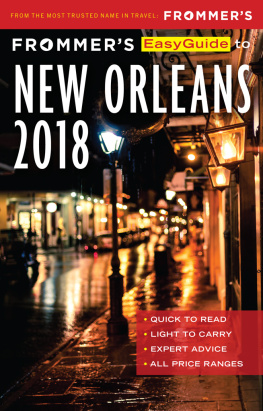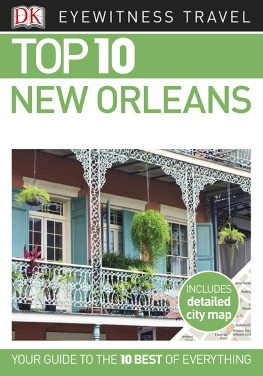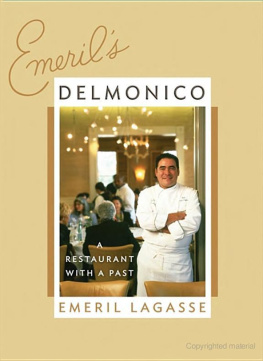

Published by The History Press
Charleston, SC 29403
www.historypress.net
Copyright 2014 by Paul Oswell
All rights reserved
Front cover, clockwise from top left: Soniat House, Le Pavillon, Hotel Monteleone, a milk cart outside La Louisane and the Roosevelt Hotel.
All photos courtesy of the respective hotels unless otherwise noted.
First published 2014
e-book edition 2014
ISBN 978.1.62585.215.1
Library of Congress Control Number: 2014951891
print edition ISBN 978.1.62619.687.2
Notice: The information in this book is true and complete to the best of our knowledge. It is offered without guarantee on the part of the author or The History Press. The author and The History Press disclaim all liability in connection with the use of this book.
All rights reserved. No part of this book may be reproduced or transmitted in any form whatsoever without prior written permission from the publisher except in the case of brief quotations embodied in critical articles and reviews.
To John, Marie and David.
CONTENTS
ACKNOWLEDGEMENTS
Many thanks to my editors Kirsten Schofield, Julia Turner and Chad Rhoad for their hard work, assistance and patience. Thanks to all at The History Press. Many thanks to Eric, Jennifer and all the staff at the Historic New Orleans Collection Williams Research Center. Special thanks to Marc Becker of the New Orleans Hotel Collection for his support and insider knowledge and to Jenny Adams for her kind help on very short notice. A huge thanks to everyone at each of the hotels who assisted me and, in some cases, fed and sheltered me: Richard Poe II and Cassie Holman, Caitlin Switzer, Pam Sitzman, Janna Holderer, Roberta Grove, Danielle Plauche-Shaw, Amy Valentino, Nikki Ritzenthaler, Betsie Gambel, Jodi LaFranca, Paul Loisel, Megan Uram and Emily Liuzza. Thanks to Kevin OMara for suggesting that I might be up to this task in the first place and for taking the authors photo. Thanks to all my New Orleans friends and family for their encouragement, support and for selflessly drinking cocktails in hotel bars with me.
INTRODUCTION
My first visit to New Orleans was in 2001. Ill never forget stepping off that plane at Louis Armstrong Airport after a thirteen-hour journey from London, Englandstraight into that sweet, sweaty, cloying heat. If youve been here during the summer months, youll know the heat I mean. I chose to visit in July for some unknown reason. I guess I didnt know any better back then.
The first hotel I stayed in here wasnt particularly historic. In fact, it was undeniably modern: the W New Orleans on Poydras Street. Even as I write, that same hotel is slowly transitioning to become a new hotelLe Meridien. Yes, its a change of name within brands owned by the same corporation, but it also neatly reflects the subtle changes that the New Orleans hospitality industry constantly reacts to. These changes have shaped the citys character as well as its physical skyline, and this is the story I wanted to tell here.
Researching this book, I was also fascinated by the fact that the neighborhood surrounding the W Poydras was witness to some of the citys most dramatic developmentsevents that influenced the complicated political and social history of the Crescent City.
Ive now been lucky enough to have been a guest at the majority of the hotels in this beautiful city. Their rooms have witnessed fortuitous successes, glorious failures, love affairs, dramatic break-ups, drunken escapades and long hours of soul searching over room service sandwiches. And thats just when Ive been staying at them.
Hotels have been an integral part of life in New Orleans since their inception. They have played host to pirates and politicians (no cheap jokes, please), provided a stage for the citys wildest celebrations as well as, in the times of slavery, its most shameful practices.
In the rooms of New Orleans hotels, military campaigns were plotted, treasure was divided, assassination plots were uncovered, great works of literature were inspired, celebrities were courted, tragedies were witnessed and disaster relief efforts were coordinated. Radio stations broadcast from their top floors, great jazz musicians lit up their ballrooms, authors drank way too many cocktails in their bars (and occasionally did some writing) and, in the most extreme of times, official seats of government were even set up within their walls.
Whole lives were led and dramatic deaths took placeand the numerous tours that take place every evening in the French Quarter tell us that we have the ghosts to prove it. For the supernaturally inclined, and for our general amusement since thats how we roll in New Orleans (where we put the fun in funeral), Ive included any haunted tales in the lagniappe section at the end of each chapter. This is a city, after all, where the real estate notices that hang outside houses sometimes have an extra board attached to the For Sale sign that reads, Not Haunted.
As for lagniappe, its a local term that means a little something extra given out to the customer for free. Here youll find gossip, trivia, ghost stories, celebrity residents and all manner of other frivolous details.
If youre ever in New Orleans, no matter where youre staying, I very much recommend touring (with a cocktail, of coursethats practically obligatory) the Monteleone, the Roosevelt, Le Pavillon or, in fact, any of the hotels mentioned in this book. Slivers of history are there to be seen, and if youre lucky, you might even run into employees who were there at the time. People stay a long time if they have good jobs in honorable places, and in every old hotel I went to, the longtime employees (some there for thirty, forty, fifty years) all said the same thing: Its like a family here.
They wont need much persuasion to tell you their stories. No doubt there are dozens that remain untold. I hope you enjoy the ones I relate to you here.
PAUL OSWELL
New Orleans, 2014.
A NOTE ABOUT ADDRESSES IN THE FRENCH QUARTER
As I started research on the addresses of some of the older buildings and hotels, I came to a quick conclusion, one that on further reading seemed to be backed up by far more accomplished authors and researchers than myself. Essentially, in the nineteenth century, the address system in New Orleans, and particularly the French Quarter, wasto put it diplomaticallycharmingly inconsistent. The standard numbering of houses that we assume now dates back to 1894, so all addresses referred to after that date correspond directly to their modern-day equivalents. I have, where possible, used modern-day addresses when referring to numbered buildings before 1894, but a more useful way of locating buildings was just to name the corners of the streets on which they stood. My apologies for any errant addressesit wouldnt be New Orleans if the sun didnt rise over the West Bank, street pronunciation wasnt a linguistic guessing game and addresses didnt entail at least a small amount of confusion.
SELECTED TIMELINE
1799: Hotel dOrleans opens, the first recognized hotel in the city.
1824: The Orleans Theatre and Hotel, Beales Hotel and Le Veau Qui Tte are listed as hotels in the city directory.
1825: Anecdotal evidence that LHtel des Etrangers is operating; reports say that the Marquis de Lafayette stayed there.
1827: The Planters Hotel on Canal is reported as being open for business.
1832: Bishops City Hotel opens on the corner of Camp and Common Streets.
Next page
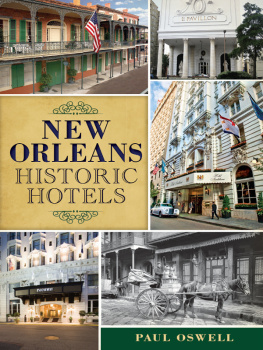

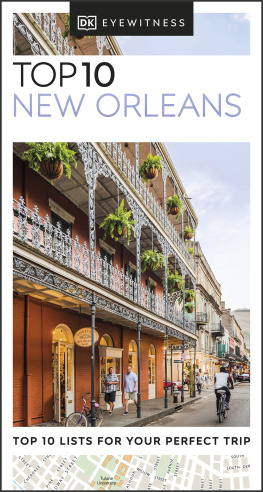
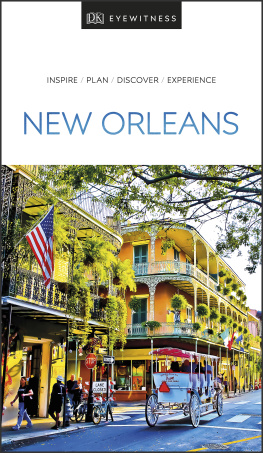
![Schwam - Frommers New Orleans [2011]](/uploads/posts/book/250009/thumbs/schwam-frommer-s-new-orleans-2011.jpg)
